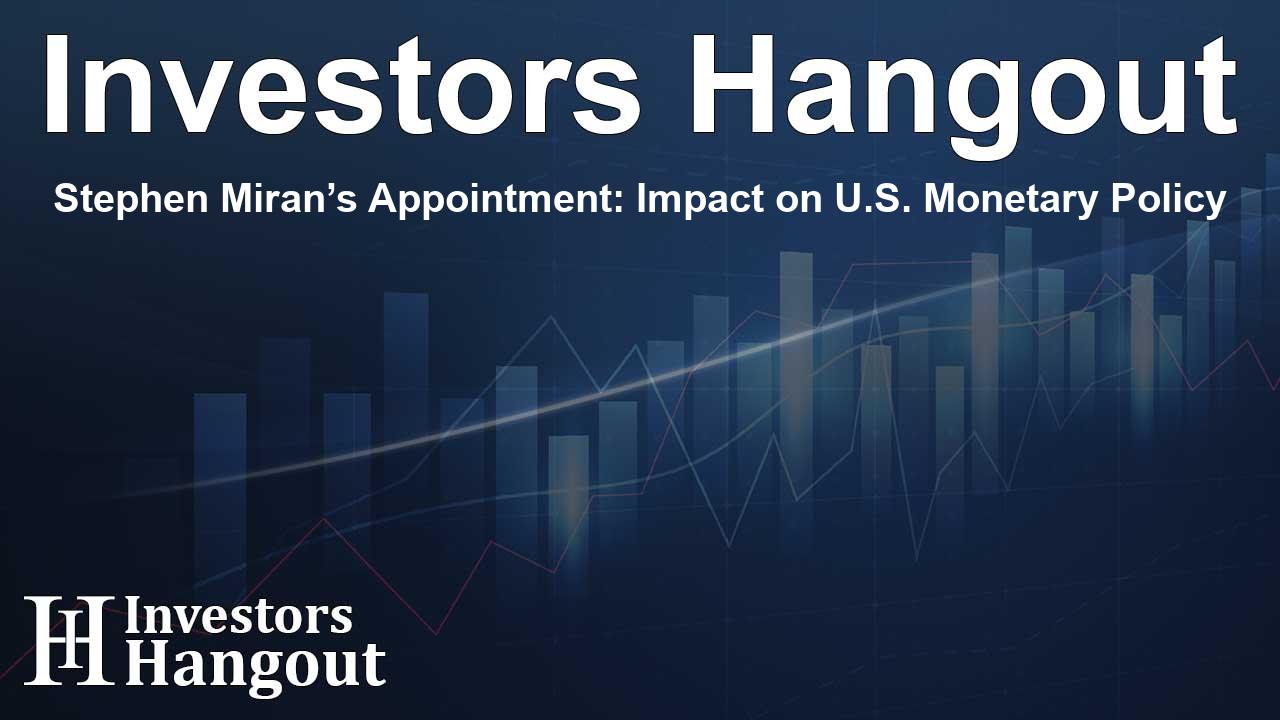Stephen Miran’s Appointment: Impact on U.S. Monetary Policy

Stephen Miran Joins the Federal Reserve
Stephen Miran’s recent appointment to the Federal Reserve marks a pivotal shift in the economic landscape of America. He has been closely associated with the plan known as the "Mar-a-Lago Accord," which seeks to remodel the nation’s approach to its economic policies. Miran's insights could potentially reshape how we view the global economic dynamics between the dollar and other currencies.
What makes this change particularly significant is the current economic climate where gold prices are surging. As investors seek safe havens, this trend indicates a shift in market confidence. The expectation is that under Miran's influence, the Federal Reserve will play a crucial role in steering monetary policy in favor of adopting new economic strategies that could stabilize and even elevate the economic standing of the country.
Gold prices have soared, recently crossing the $3,400 per ounce threshold—a major milestone. Miran’s presence at the Fed reveals why savvy investors have been stockpiling gold; they anticipate a major policy shift that prioritizes stability before the anticipated economic changes roll out.
The Ramifications of Miran’s Influence
Miran’s influence goes beyond merely advocating for rate cuts; it embodies a strategic positioning of key political and economic philosophy within the Federal Reserve itself. The Federal Reserve controls the flow of money—a fundamental aspect of Miran’s Reset strategy. By having a strategist focused on reshaping how the dollar is perceived globally, Miran holds the potential to influence the future of American economic policy.
His role will allow him to exercise direct control over interest rates and the manipulation of the money supply, with the aim of facilitating gradual dollar devaluation. This could prove essential in implementing a comprehensive economic plan that deeply aligns with broader government goals.
The implications of this shift cannot be understated. With his strong understanding of economic mechanisms, Miran positions himself as a significant player in the future direction of American monetary policy.
Historical Context: Lessons from the Plaza Accord
The Plaza Accord of 1985 serves as an important historical backdrop to understanding the potential pathways available for Miran and the current administration. Following that pivotal agreement, aimed at coordinating a devaluation of the dollar, gold prices also experienced a striking increase due to market adjustments.
In earlier instances, when international authorities sought to negotiate currency adjustments, it was essential for the Federal Reserve's leadership to align with that vision. The integration of the governing body’s strategy with economic policy proved vital in modifying market conditions to favor devaluation. Miran's current role is set against this historical understanding, signifying an effort to ensure the Fed is harmonized with the government's broader economic agenda.
The Future Outlook for Gold and Currency Value
Given the historical precedents, any forthcoming changes leveraged by Miran could propel gold to unprecedented heights. Analysts foresee potential price jumps, possibly setting gold's worth between $5,000 to $8,000 per ounce, if the strategy unfolds as intended. As the economic environment grows increasingly complex, the feedback loop from such a narrative could reshape how markets react and adapt to the pressing needs of the economy.
It's worth noticing how the dynamics of the dollar's value directly affect gold prices. Should the influence of Miran facilitate a decline in the dollar’s dominance, investors will be watching closely as this could bring further shifts in asset values and market confidence.
Overall, Stephen Miran’s appointment at the Federal Reserve does not merely represent another bureaucratic choice; it underscores a transformative intent to redefine the paths of economic policy and influence market behaviors significantly.
Frequently Asked Questions
1. Who is Stephen Miran?
Stephen Miran is the newly appointed governor at the Federal Reserve known for his involvement in the Mar-a-Lago Accord.
2. What does the Mar-a-Lago Accord refer to?
The Mar-a-Lago Accord refers to a comprehensive plan aimed at transforming the U.S. dollar's status and overall economic strategy.
3. How does Miran’s appointment impact the dollar?
Miran’s role at the Federal Reserve could lead to strategies that may result in a devaluation of the dollar to align with broader economic goals.
4. What is the significance of gold prices rising?
The rise in gold prices signifies investor confidence in safe-haven assets in anticipation of potential economic shifts influenced by Miran’s strategies.
5. Can we expect major changes in the Federal Reserve's policies with Miran?
Yes, Miran’s appointment is expected to drive significant changes in monetary policy aligned with the broader economic strategy proposed by the current administration.
About The Author
Contact Dylan Bailey privately here. Or send an email with ATTN: Dylan Bailey as the subject to contact@investorshangout.com.
About Investors Hangout
Investors Hangout is a leading online stock forum for financial discussion and learning, offering a wide range of free tools and resources. It draws in traders of all levels, who exchange market knowledge, investigate trading tactics, and keep an eye on industry developments in real time. Featuring financial articles, stock message boards, quotes, charts, company profiles, and live news updates. Through cooperative learning and a wealth of informational resources, it helps users from novices creating their first portfolios to experts honing their techniques. Join Investors Hangout today: https://investorshangout.com/
The content of this article is based on factual, publicly available information and does not represent legal, financial, or investment advice. Investors Hangout does not offer financial advice, and the author is not a licensed financial advisor. Consult a qualified advisor before making any financial or investment decisions based on this article. This article should not be considered advice to purchase, sell, or hold any securities or other investments. If any of the material provided here is inaccurate, please contact us for corrections.
